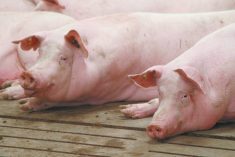Canadian farmers have had lots of experience with trade wars but, in the past, it was usually because they were caught in the crossfire.
Perhaps the biggest mess unfolded in 1985, when the Americans decided to go head-to-head with the European Union in a battle over who could sell grain cheapest to clear out huge stockpiles that had accumulated due to post-Second World War policies designed to restore food security.
Grain industry sources were speechless when contacted on the day the U.S. announced its Export Enhancement Program. They had no words for the economic bloodbath they knew was coming.
Read Also

Separatist leader says agriculture would prosper
Alberta separatist party leader Cameron Davies outlines what he thinks are the benefits to the agriculture industry if the province were to become sovereign
The EU and U.S. were subsidizing exports while simultaneously supporting their farmers, which drove global grain prices into the trenches yet incentivized their farmers to keep on producing. Smaller exporters, including Canada, which lacked the budgetary capacity to play the same game, took it on the chin.
Ridiculously low grain prices combined with high interest rates drove thousands of Canadian producers out of business and spawned black humour jokes about parents being accused of child abuse for leaving their kids the farm. It also pushed remaining industry towards the remarkable efficiency it’s noted for today.
There was eventual realization that this so-called war was costly — and produced no winners.
When the dust had settled and the grain stockpiles cleared, global market share hadn’t changed a whole lot. Grain importers took full advantage of the cheaper prices, but they didn’t buy more. After all, there’s only so much the market can eat. Economists call it “inelastic demand.”
In the end, sanity prevailed, and countries coalesced around the General Agreement on Tariffs and Trade, an effort to bring discipline into how exporters support their producers and manage exports. These were hard-fought gains that levelled the playing field and made it possible for export-dependent countries such as Canada to thrive in the global grain and oilseed business.
Fast forward 40 years and Canadian farmers find themselves on the cusp of an equally perilous trade war, and in an unusually awkward position. Not only are their two biggest customers — the U.S. and China — scrapping with each other, but they are both taking aim at Canada.
Sixty per cent of Canada’s agri-food exports go to the U.S. More than half of our agri-food imports originate there, making it Canada’s biggest trading partner by far. In recent times, China has been Canada’s biggest customer for wheat and canola.
The difference this time round is that these two heavyweights in the global grain business aren’t going after export markets; they are weaponizing access to their domestic consumers — the U.S. through tariffs and China potentially through anti-dumping sanctions.
It turns out that the many benefits of a more globalized economy haven’t flowed equitably, which has sparked a protectionist backlash, giving rise to rhetoric such as America-first and to leaders such as U.S. President-elect Donald Trump.
Barriers that make access to either of these key markets more expensive will depress global prices and make it harder for Canadian farmers to sell their grain.
It’s uncertain whether Trump will carry through with his highly publicized tariff threats. The highly integrated cross-border flow of agricultural commodities and processed goods means any trade disruptions will hurt U.S. producers, consumers and processors almost as much as they do Canadians, unless the U.S. government steps in like it did the last time to offer compensation or, alternatively, if Trump acts on his musings to attempt to fully integrate Canada.
China is a different story. Outside observers have long debated whether the world’s second most populous country will be able to feed its over 1.4 billion people, and its leadership has consistently proven the naysayers wrong.
UN Food and Agriculture Organization data shows China produces a quarter of the world’s grain and feeds one-fifth of the world’s population with less than 10 per cent of the world’s arable land. Late last year, it announced plans to dramatically increase domestic consumption of cereals over the next decade while investing in modernizing its agricultural sector to stabilize output.
It’s a plan that implies further withdrawal from global engagement rather than increased integration, but it will be costly and won’t happen overnight.
The global pendulum has swung decidedly into the protectionist zone. Like the last time, it’s hard to see how any of the players emerge from this a winner, but it could still take years before a new equilibrium is established. Maybe world leaders will get it right next time.
In the meantime, Canadian farmers had better brace for leaner times.
















